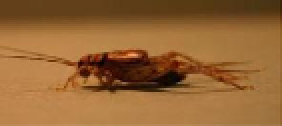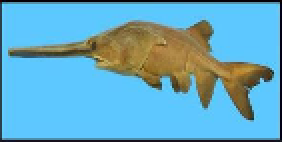Biomedical Engineering Reference
In-Depth Information
Parasitoid fly,
Ormia ochracea
Sound
localization
It has localization ability to
the sound sources within 2
degrees azimuth [4].
Cricket,
Acheta domestica
Acoustic or
flow sensing
Mechanosensory system can
recognize weak, low-
frequency air current in
tens of Hz [5].
Paddle fish,
Polyodon spathula
Electric
sensing
The input stimulus is far too
weak to induce firing events,
but the added environmental
noise enhances the detection
[6].
Electric fish,
Apteronotus
albifrons
Electric
sensing
It detects small prey in the
dark at a distance of
approximately 1.2 -5.8 cm
in time course of distance
35 µs/cm [7,8].
FIGURE 2.1
Efficient sensing in organisms of sound localization, flow sensing, and electric sensing. (Images from Wiki-
pedia and Encyclopedia of Life.)
can overcome constraints imposed by noise
and environmental artifacts to achieve remark-
able performance (illustrated in
Figure 2.1
). For
example, the parasitoid fly (
Ormia ochracea
) can
localize the sound of crickets with a remarkable
accuracy of less than 2°. Even though the fly's
eardrums are spaced less than 0.5 mm apart, it
can successfully overcome the physical con-
straints due to sound propagation and resolve
localization cues of less than 50 ns
[4]
. Another
marvel of biology is the filiform hair in the
cricket (
Acheta domestica
) that exhibits exquisite
vibration-sensing capabilities. These mechano-
receptive sensory hairs have been shown to be
capable of sensing vibrations as low as tens of
μ
m/s flow speed, even in the presence of large
ambient noise
[5]
. Yet another example is the
electro sensory receptors in the paddlefish (
Poly-
odon spathula
) that the fish uses to sense and
localize plankton, even in the presence of ambi-
ent aquatic turbulence
[6]
. A similar mechanism
is also found in the electric fish (
Apteronotus albi-
frons
) where the performance of the receptors
has been shown to supersede the state-of-the-
art manmade impedance spectroscopy systems.
Using neurobiological techniques, the organs
of the electric fish can monitor microvolt-level
voltage perturbations caused by surrounding
objects and detect small prey at distances greater
than 25 mm
[7, 8]
.









